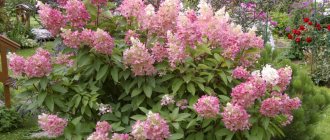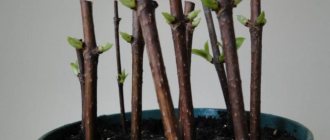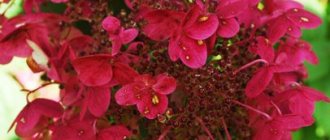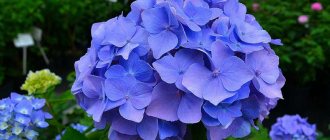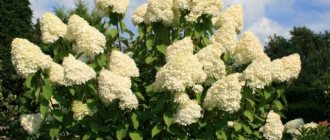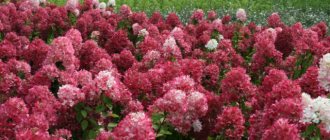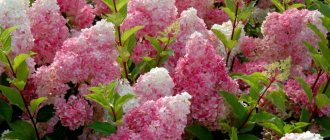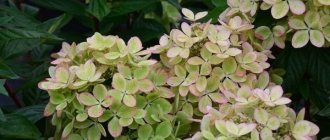What's in your name?
Bobo is a dwarf hydrangea variety. The dimensions of the bush are about 70 cm in height and approximately 50 cm in diameter. White flowers are collected in large wide-conical inflorescences. Throughout the season, they change color from greenish, turning into white, to soft pink. The leaves are dark green. The most abundant flowering of Hydrangea paniculata Bobo is from July to September.
The variety is winter-hardy, but young plants need to cover the roots with a mulch layer. In the middle zone, Bobo hydrangea overwinters without shelter. In northern regions it is necessary to cover for the winter.
Hydrangea Bobo (see photo in the review) is well suited for decorating flower beds and borders. It is used for landscaping small gardens and personal plots. Hydrangea grown in containers decorate terraces and balconies.
Characteristics of the variety
| Hortense Bobo | |
| general characteristics | Deciduous-flowering dwarf shrub |
| Plant height | up to 70 cm |
| Flower size | up to 15 cm |
| Color | Green-lemon, white-pistachio, pink, cream |
| Bloom | June - September |
| Winter hardiness | Frost-resistant |
Hydrangea paniculata Bobo was bred in 2011 by Belgian breeders under the name Hydrangea paniculata Bobo. In such a short time, she became famous for her beauty. It is the leader among dwarf hydrangeas in terms of abundance of flowering and decorativeness: the color of the buds changes from green-lemon to white-pistachio, then to pink and cream:
- it is a deciduous-flowering shrub, classified as a dwarf;
- height during budding - does not exceed 70 cm;
- growth rate - approximately 10 cm per season;
- at the age of 3–4 years it acquires a spherical shape with a diameter of 60 cm;
- propagated by seeds, layering, dividing the bush;
- is characterized by unpretentiousness and frost resistance;
- due to its compactness, it can be grown in flower beds, looks harmonious in group compositions, and is used for zoning an area.
The inflorescences of paniculata Bobo are 15 cm high, their diameter is 7–10 cm.
The variety has erect, rigid shoots, they firmly hold the paniculate flowers, so the crown does not fall apart even after rain, like other types of hydrangeas. Red-brown shoots look good in a leaf fall field, and if you don’t cut off the inflorescences, the bush will decorate the area in winter.
The inflorescences consist of numerous small flowers collected in a pyramidal shape
Long flowering - June-September. Mature bushes have high winter hardiness. Bobo does not freeze without shelter at -30...-34 °C, so the plant is in demand in cold regions of Russia.
The table contains a selection of photographs of blooming hydrangea, demonstrating the seasonal change in color of the buds:
| June July The beginning of bud formation in temperate climates occurs at the end of June. The panicle, consisting of small flowers, blooms gradually. The opening buds are green, during the blooming process it changes to pistachio | |
| July By the middle of the month, most of the inflorescences are fully open. The pistachio shade gradually becomes lighter. Flowering bush turns white | |
| August By the end of summer, the panicle has completely blossomed, and the process of seed ripening begins. At this time the petals take on a pink tint. | |
| September At the beginning of the month, with the arrival of cool nights, a change in color begins - the inflorescences turn pale and begin to dry out. Shades of pink are almost invisible, the bush is covered with cream pastel |
In the first 2 years, young seedlings need to be covered with non-fabric or spruce branches. In the third year, the plant already acquires a strong root system and becomes resistant to unfavorable conditions.
How to prepare hydrangea for planting?
You can plant hydrangea in both spring and autumn. In cold climates, it is better to plant in the spring; over the summer, the seedlings will take root well and withstand the harsh conditions of the first winter. For spring planting, shorten rhizomes and trim annual shoots, leaving 3-4 pairs of buds.
First you need to decide on the landing site. Hydrangea Bobo prefers slightly acidic and moist soil. It is advisable to allocate a place for planting in partial shade. This variety does not tolerate direct sunlight. In this case, as with many types of hydrangea, the inflorescences become small and lose color.
Selection of location and conditions of detention
Hydrangea cannot be considered one of the most unpretentious plants. But you can provide her with ideal living conditions and optimal care without much difficulty. Even a novice gardener can grow Bobo hydrangea.
Lighting and location
Hydrangea Bobo does not like direct sunlight. The optimal place for planting it in open ground is a shaded area, partial shade. If you plant a shrub on the sunny side, it will grow and develop poorly. And the inflorescences will lose volume and color.
Temperature
This hydrangea variety was bred specifically for European countries. Therefore, Bobo feels good in the Russian summer if the right place is chosen for her: it does not get hot in partial shade. The plant also tolerates winter frosts well. In central Russia and southern Russia, shrubs overwinter without shelter, with the exception of young seedlings, which may die without it. Insulation for the winter is also required for hydrangeas grown in the northern regions of the country.
Air and humidity
Hydrangea loves moist air, but does not tolerate stagnation. Therefore, the place where it grows must be well ventilated. Otherwise, the bush will get sick. But the plant does not tolerate drafts and sharp cold winds. Therefore, you should not plant hydrangea in open areas.
Priming
The shrub prefers to grow on fertile and loose soils with a slightly acidic reaction. Then the flowering will be long, and the inflorescences will be voluminous and bright.
How to perform a transplant step by step?
The root system of this variety is shallow but branched. Plant the bushes at a distance of one meter from each other. To get one large and lush bush, it is better to take 3-4 year old seedlings for planting. Planting Bobo hydrangea:
- Dig a hole with a diameter and depth of at least 30 cm.
- Apply mineral and organic fertilizers.
- Pour sand mixed with peat.
- Spread the roots of the seedling and gently sprinkle with soil. The root collar of the seedling is not buried.
- Water the bush well.
- When the water is absorbed, mulch with sawdust or peat with a layer of 6-8 cm.
Planting process
A step-by-step description of planting seedlings of Hydrangea paniculata Bobo in open ground:
- Preparation of planting holes . Dig holes up to 30 cm in diameter. Their depth will depend on the quality of the soil. If it is loose, well-drained and fertile, then 30 cm is enough. If it is heavy, does not allow water to pass through well and is poor in minerals, then a greater depth is required (up to 40-50 cm). In this case, a drainage layer is formed at the bottom of the pit to remove excess moisture, and then a mixture of humus and peat is poured. Add 50 g of mineral fertilizer (nitrophoska, azofoska or other) to each well. The optimal distance between holes is 1 meter.
- Landing. Hydrangea has a small root system, but very branched. In addition, the bush does not tolerate its damage very well. Therefore, you need to plant it very carefully. Place the seedling in the hole and straighten its roots. Holding the plant with one hand, fill the hole with fertile soil or a mixture of peat and humus with the other. The hydrangea needs to be buried to the root collar.
- Watering. Lightly compact the soil around the seedling so that it does not settle during watering. Form a roller around the bush that will hold water near the roots. Water the hydrangea generously with settled water.
Advice! Sprinkle the wet soil surface with a small layer of dry soil. This will help prevent a hard crust from forming.
How to care for the plant after planting?
Caring for Bobo paniculata hydrangea is quite simple. Nevertheless, there are several rules that must be followed in order for the bush to grow healthy and delight with its flowers.
Hydrangeas require regular watering. It is better to use rain or settled water for this purpose. The main thing is that there is no lime in the water. Since its presence can simply destroy the hydrangea. In dry weather, water 2 times a week, at the rate of 30-50 liters per bush.
After watering, the soil needs to be loosened. To maintain moisture under the bush, mulch the soil 2-3 times a year with sawdust, pine needles or leaf humus. When mulching with peat, it is necessary to reduce watering.
At the beginning of June, the plant should be fertilized with a solution of slurry and mineral fertilizer. A mixture of superphosphate with ammonium and potassium nitrate is suitable for this purpose. This fertilizing will improve flowering and allow for the formation of healthy buds for next year.
During the formation of buds, the plant must be fed with a mixture of superphosphate and potassium sulfur. In August-September, the bush needs to be prepared for wintering - put 15-20 kg of compost or rotted manure under it. Treat hydrangea branches with Bordeaux mixture. In October, hill up the plants to a height of 30 cm. In November, bend the branches of the bush to the ground and cover them with spruce branches.
Bobo hydrangea care
Care includes regular watering, loosening the soil, fertilizing, pruning and weeding. Hydrangeas are aquatic flowers and are sensitive to lack of water. In spring and before flowering, it is good to feed with mineral fertilizers.
Trimming
After flowering, dried flowers retain their decorative qualities until spring, so they should not be cut out. Pruning is carried out in early spring before the beginning of the growing season every year: dried inflorescences are removed before the first pair of strong buds. Too careful pruning is not required, as it may lead to poor flowering. If the bush is too dense, it is enough to remove old, weak and bent branches with roots.
Young, recently planted bushes do not require heavy pruning. It is necessary to inspect the bush and selectively remove damaged and weak branches. We cut all last year's shoots tightly at the same height: 1-2 pairs of well-educated and healthy eyes.
Note ! It is imperative to remove all diseased, damaged and intersecting branches that excessively thicken the bush.
This procedure is very simple for beginner gardeners, so there is no need to be afraid of it, since even if done incorrectly, it will not deprive you of all the flowers this season. And lack of cutting will make the plant overgrown with small flowers. The procedure must be performed on a frost-free, clear day using clean, sharpened instruments.
Woody shoots of larger diameter (more than 1 cm) are recommended to be lubricated with a horticultural fungicide ointment to limit the risk of infection. Trim all shoots low.
Watering mode
All types of hydrangeas require regular watering, especially in dry sandy soils and in hot sun. There should always be a lot of moisture; it is advisable to cover the soil with a layer of mulch with the roots. This is the main concern for hydrangeas. It is best to water in the early morning or late evening, when there is no scorching sun, with cold water. But you can sometimes set up irrigation throughout the day.
Important ! Under no circumstances should you water with water containing lime!
Even a small water deficit causes wilting of both leaves and inflorescences. During the period of growth and flowering, hydrangea is watered daily; the soil should be constantly moist, but not flooded. Remember that when watering, do not pour water on the flowers.
After watering
Top dressing
Hydrangea needs soil that is permeable to air and retains moisture well.
The most common feeding methods:
- Adding peat and humus to improve soil properties.
- Potassium fertilizers - to increase frost resistance and good flowering.
- Iron and aluminum - in order to acidify the soil and result in blue flowers.
It is enough to feed 2 times a year: in the spring - organic fertilizer, in the bud formation phase - a liquid mixture of urea, potassium and superphosphate. You can also purchase liquid fertilizers, which you can water the plants with once every 7-10 days.
Note ! Feed the plant for the last time no later than the end of August.
Features of care during the flowering period
If the crop has thin shoots, then they need to be tied up, especially when mass flowering begins, otherwise the branches may break.
Each owner of a chameleon bush is able to control the color of its flowers; you just need to change the acidity of the soil. To obtain a red-pink color, you should maintain a more alkaline soil; acidic soil turns the flowers blue-violet.
Hydrangea propagation
Dividing the bush. Hydrangea can be propagated in this way both in autumn and spring. The bush is divided so that each part has a renewal bud.
By layering. Bend young shoots to the ground and dig in, leaving a top of about 20 cm above the ground. The next year, separate the rooted shoot from the mother bush and separate it.
By cuttings. This is the most common method of reproduction. In April-June, cut annual shoots at right angles, 10-12 cm long. Remove the top of the shoot, as it is not suitable for cuttings. Remove leaves from the bottom and place in root stimulator solution. Once the roots appear, plant them in the ground.
Reproduction
If you want to propagate Bobo hydrangea, you can use three methods: cuttings, dividing the bush and layering. Each of these methods is used at a certain time, and each of them has its own advantages and disadvantages.
Cuttings
Using green cuttings, you can propagate this variety very effectively. They are usually cut in early spring, before buds form.
Important! Insect pests that settle on hydrangeas can be carriers of viral diseases that cannot be treated and lead to the death of the plant.
This process is carried out in the following sequence:
- Choose healthy, strong shoots with at least 5 buds.
- Cut cuttings from them and soak them in a solution of a root formation stimulator.
- Stick them into open ground in a shaded place protected from drafts to the depth of two buds.
- Keep the soil moist to help the cuttings root as quickly as possible.
After rooting, each of them will need to be transferred to a separate container and grown for about two years, and then planted in a permanent place. This method is quite lengthy, and besides, not all cuttings can subsequently become full-fledged plants.
By layering
It is best to propagate by layering in May.
Learn how to replant hydrangeas to another location.
To be most effective, you need to do the following:
- Bend a good young shoot to the ground.
- Make a cut in the part that touches the soil.
- Sprinkle with peat and constantly maintain the required level of humidity.
- After the roots have formed at the site of the cut, carefully separate the cuttings from the large bush and transplant them into a separate container, where they will grow and wait for planting in a permanent place.
Dividing the bush
This method, like cuttings, is also practiced in early spring, when flower buds have not yet appeared.
We advise you to find out why paniculate hydrangea does not bloom.
For this purpose the following events are carried out:
- Dig up a large bush.
- Divide it into several parts so that each of them has buds.
- Shorten the roots a little.
- Dig holes twice as large as the size of the root system of young bushes.
- Fill it halfway with fertile soil consisting of peat, compost and mineral fertilizers.
- Carefully place the bushes in the holes and sprinkle with the rest of the soil mixture.
- Tamp down a little and water the new plant well so that it takes root and begins to grow as quickly as possible.
This method compares favorably with others due to the fact that it is the simplest and fastest. But it can only be used if the bush is too large and can be divided.
What is needed to form a beautiful bush?
Hydrangea Bobo, whose care includes pruning, produces many shoots already in the first year. And if you do not trim the plant regularly, the bushes will not only look neglected, but also the quality of flowering will deteriorate over time.
Hydrangea is pruned in the spring when the buds swell. Leave a few strong stems and cut off the rest. Trim young shoots to 4 buds. This way they will survive the winter better. A few stronger shoots should be left to replace the already faded stems.
When pruning, the main thing is to take time so that the plant has enough time to develop new growth.
Pests and diseases: methods of protection
Bobo hydrangea is considered a hardy plant. But improper care and difficult climatic conditions can lead to depletion of his strength and decreased immunity. That is why it is advisable to carry out preventive measures - spraying bushes against infections and pests.
Before the growing season, the crop is sprayed with a solution of copper sulfate in the spring. Alternative preparations to the classic solution are Oxychom, Topaz, Fitosporin.
Similar articles:
Rudbeckia - the secrets of proper planting and caring for the plant
Tree hydrangea - secrets of planting, care, propagation
How to replant an apple tree - the secrets of proper replanting
Diseases and can they be avoided?
As stated by the breeders in the description of the Bobo hydrangea, this variety is not susceptible to any serious diseases. Pests, spider mites and aphids can also be called “random visitors”.
Chlorosis can be determined by yellowing leaves and small inflorescences. The cause of this disease is an excess of lime in the soil. To avoid this, it is necessary to feed Bobo hydrangea with iron salts and mineral fertilizers.
Powdery mildew covers the plant with a white coating - both leaves, buds, and stems. The disease destroys the bush, the leaves become deformed and dry out, the stems stop growing and wither. The control method is to remove the infected parts and treat with fungicides.
Pests of Bobo hydrangea are slugs, spider mites and aphids. Slugs can be controlled using special preparations. Fitoverm works well against spider mites. 3-4 treatments with this drug will help get rid of the pest. An infusion of 200 g of garlic and 50 g of laundry soap per 10 liters of water will help cope with an aphid infestation.
Hydrangea paniculata diseases
Hydrangea Bobo is not susceptible to various diseases if all care conditions are met. If any rules are violated, the flowering period becomes the most vulnerable. In this case, it is important to understand the cause of the disease and eliminate the cause as soon as possible.
Among the most dangerous options may occur:
- chlorosis, in which the leaves begin to turn yellow and the shoots become very brittle, treatment is carried out using copper sulfate smears;
- gray rot - it manifests itself in the form of a weeping coating that cannot be removed, in this case watering is reduced and treatment is carried out with Bordeaux mixture;
- when affected by spider mites, white spots appear on the leaves, and subsequently they dry out; special means are used for treatment;
- leaf aphids can spoil the appearance of Bobo hydrangea in a short time; you can get rid of them using complex means.
Due to high humidity and rainy weather, hydrangea can develop powdery mildew. You can distinguish it by the white coating on the shoots and leaves. In this case, you need to dry the soil as much as possible and treat the plant with antifungal agents.
Reviews from gardeners
Hydrangea Bobo fully corresponds to the description: it blooms in early June and pleases with its openwork inflorescences all summer. Bushes planted in different places grow in different colors - white, slightly greenish, pale pink. For the third year, the plant blooms with lush inflorescences and does not shrink.
Hydrangea Bobo (the description and photo confirm this) is perfect for beautifying the site and garden. Gives them a truly decorative look. This variety is good for single plantings and combines well with other plants.
With the help of a haircut, you can create any volume and shape. When creating flower arrangements, you need to take into account that Bobo hydrangea gradually changes color over the course of the summer. In a small garden, one lush bush is a simply fantastic sight. All the beauty of this flower is revealed.
Landing Features
To grow a strong bush that will bloom luxuriantly and for a long time, you must adhere to some growing rules.
Hydrangea paniculata bobo description
Deadlines
Planting is carried out in early spring, so that during the season the seedlings have time to take root and prepare for winter.
Depending on the region, the timing is different - from mid-March to the first ten days of April. The main thing is that the soil warms up to 10-12°C and the threat of return frosts passes.
It is also important to do this before the beginning of the growing season, when the leaves have not yet begun to bloom.
Selecting a location
Prefers to grow in a well-lit place with sun. It is better to plant away from trees and shrubs, otherwise the plant will suffer from a lack of moisture, nutrients and light.
It does not grow well in wetlands, so choose an area with groundwater to a depth of 3 m.
The soil is light, loose, enriched with organic matter. Can be planted on sandy loam or loam. The optimal acidity level is 6-7 units. If this indicator is higher, the planting area is sprinkled with dolomite flour, slaked lime or chalk at the rate of 400 g/m².
They prepare the site in advance - remove garden waste and plant debris two weeks in advance. Then they dig up and level.
Preparation of planting material
You can purchase seedlings of this variety in one of the flower shops. It is better to give preference to mature specimens that have a branched crown and a well-developed root system.
Hydrangea bobo
As a rule, bushes are sold in containers or pots. Plants with bare roots should not be purchased, as they may not take root after planting on the site.
When choosing, inspect the stems and leaves - they should be fresh, without signs of pest damage. Any growths, cracks, or breaks indicate the non-viability of the seedling, which is better to discard.
Before planting, the plant needs to be prepared - water it generously, remove it from the container, trim the roots by 3-4 cm to stimulate the growth of new shoots after planting.
Landing technique
They dig holes slightly larger than the root system - 60x70 cm. A little drainage - pebbles or crushed stone - is poured into the bottom. This material promotes the rapid drainage of excess moisture. Then they are half filled with light and fertile soil. Mix peat, dug soil, sand and humus in equal quantities.
They lower the roots, straighten them, fill all the voids with soil, trample them around the trunk, and water them. To ensure that moisture remains in the soil for as long as possible, the tree trunk area is mulched with rotted manure or peat.
When planting, it is important not to deepen the root collar, because if it gets wet, it will quickly rot and the shrub will die.
If you plant several seedlings at the same time, you need to maintain a certain distance - about 1 m, in a row - 80-90 cm. This way the plants will fully develop without experiencing a lack of moisture and nutrients.
Gardening tips
- Experienced gardeners note that the color of hydrangea depends on the presence of aluminum sulfate in the soil. There are drugs on sale that help it change color.
- In autumn, it is better to replant plants with a strong root system. This will allow the hydrangea to take root and become stronger before frost begins. Weak plants take longer to accept and may not survive the cold winter.
- As soon as the hydrangea inflorescences weaken and decrease in size, it needs a rejuvenating haircut. The bush is pruned “under the stump”, that is, stems 15-20 cm long from the ground are left. The plant tolerates such manipulation well. It grows very quickly and blooms luxuriantly again.
It’s not for nothing that hydrangea is called the queen of the garden. This beauty went to this title thanks to its lush and long-lasting flowering. The Bobo variety is winter-hardy and practically not susceptible to disease. Today this plant is winning the hearts of gardeners with its beauty and unpretentiousness.
During flowering, the bush looks like white lace; due to the large number of inflorescences, the leaves are almost invisible. Those who decided to have a Bobo hydrangea in their garden, a description and photo of which we presented in this review, will be pleased with its abundant and long-lasting flowering.
Origin of hydrangea
Panicle hydrangea Bobo, which appeared in Europe in the 18th century, has earned the recognition of gardeners. The delicate bushes, brought from Japan, are prized for the opportunity to admire the magnificent balls of inflorescences. Breeders from different countries helped the unique shrub fill the gardens of Europe.
The hydrangea variety Bobo (Hydrangea paniculata Bobo) was bred by scientists from Belgium, receiving an award at the Florall flower exhibition for the best new frost-resistant variety. As a result of many years of breeding work, this species now has winter hardiness and a variety of colors.
Riot of flowering
Using Bobo hydrangea in landscape design
The miniature cultivar of the luxury series can be used in different ways:
- plant hedges;
- design paths or entrances;
- perform border plantings;
- complement mixborders;
- create mobile flowerpots;
- add to flower arrangements.
The Bobo hybrid combines best with pink and white phloxes or other hydrangeas. Flowering ornamental shrubs will also be good neighbors for the hybrid.
Mixed mixborder
flower bed
Compositional fit
Border planting
Shrub propagation
Hydrangeas can be propagated by cuttings or dividing the bush. In the first case, we cut cuttings with 2 internodes. We remove the lower leaves completely, and in the upper pair of leaves we cut the leaf blade in half.
This is done in order to reduce moisture evaporation. Then the cuttings are dipped in Kornevin powder and planted in nutrient soil. In order for adaptation to proceed faster, it is necessary to cover the cuttings with a transparent glass jar according to the size of the cuttings. In about a month, the cuttings will acquire their own root system.
IMPORTANT! During cuttings, do not expose the pot to sunlight; carefully monitor the soil moisture, preventing it from drying out.
Rules for planting in the ground
It is recommended to plant the plant in autumn. It is this period that is considered the most optimal and allows the flower to take root before the onset of frost. However, in the Urals and Siberia, hydrangea is planted in the spring, since in the fall it does not have time to take root before the onset of frost.
Hydrangea Pinky Winky: description of the characteristics of the variety and its cultivation
When choosing a location, experts recommend giving preference to shaded areas. Hydrangea feels best in diffused light without direct sunlight. Planting a flower in drafts is not recommended.
Before planting the plant, you need to prepare the soil in advance. It is best if it is slightly acidic soil. To increase acidity, you can add coniferous soil or peat to the soil.
Important! Under no circumstances should you add wood ash or lime to the soil, as they are strictly prohibited for this plant.
Hydrangea Bobo loves space, so it is recommended to plant seedlings at a distance from each other ranging from 70 to 100 cm. Before planting, the holes must be prepared in advance. Their depth should be in the range from 40 to 45 cm. Be sure to lay a drainage layer on their bottom, since the flower does not tolerate stagnation of moisture at the roots.
You can plant both seeds and seedlings. The most important thing is that the planting material is of good quality.
After planting, experienced gardeners recommend not only watering the plant, but also mulching it. For planting, you should choose a windless, sunny, but not hot day.
Hydrangea Bobo in landscape design
How does it reproduce
Hydrangea paniculata Bobo propagates by layering and cuttings.
What year does hydrangea bloom after planting?
When propagating a plant by layering, planting material is taken in spring or late summer. To do this, a suitable branch is bent to the ground and fixed, buried and buried in the middle. Over the course of a year, a root system is formed on the cuttings and after that the new plant is separated from the mother plant.
The flower can be propagated by cuttings in spring and summer. In spring, cuttings are prepared from those that remain after pruning. They are kept in water for several days, and then their lower sections are treated in a root formation stimulator and planted in containers with loose and moist soil.
Summer cuttings are considered riskier rooting material. The most optimal period for breeding is considered to be from June 10 to June 15. To prepare cuttings, young shoots on which flower buds have not formed are used. They are cut into ten-centimeter sizes, the lower leaves are removed from them, keeping only 3-4 leaves on top. Prepared shoots are planted in previously prepared soil and left until new shoots form.
For reference! On average, a plant takes about 25 days to root.
Planting hydrangea
You can plant both seeds and seedlings. Most often, gardeners use the first method. The main thing is to plant high-quality seeds that have good germination. Seeds can be purchased at the market or at a nursery. The expiration date must be indicated on the packaging, along with a brief description of the variety.
Hydrangea seeds
Below are brief planting instructions:
- purchased seed is placed in special containers with peat and sand;
- The vessel covered with film is placed in a warm place;
- As the seedlings grow, picking is carried out twice;
- when the seedlings are 2-3 years old, they are planted in a previously prepared area;
- the seedling is placed in a hole 40 cm deep;
- the pit is filled with a nutrient mixture.
Hydrangea: planting and caring for it in the open ground
On a note! After planting, watering and mulching are carried out. Watering should be plentiful. Water the plant immediately after planting the seedlings in open ground.
You need to choose a fine, windless, preferably sunny, but not hot day for planting. If the day is rainy, the roots of a young plant may rot, which can lead to the death of the plant or subsequent fungal infection (grey rot, powdery mildew). If it is windy on the day of planting, the seedlings can easily break from the wind. In cases where the weather is capricious and unpredictable, you can first plant the seedlings in a greenhouse and later transplant them into open ground. This will help the plant adapt.
Planting hydrangea
